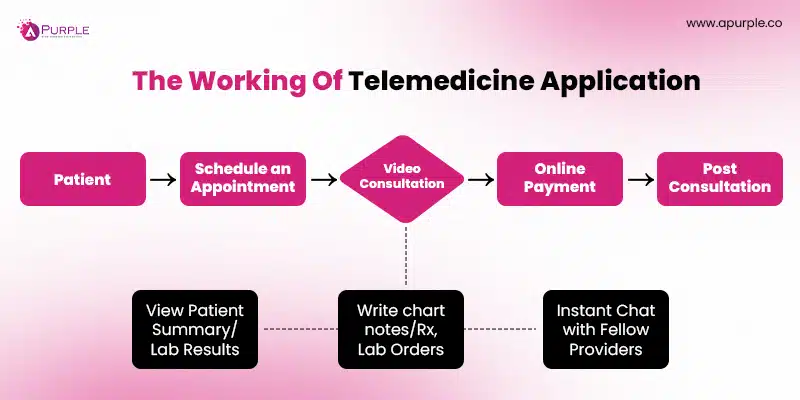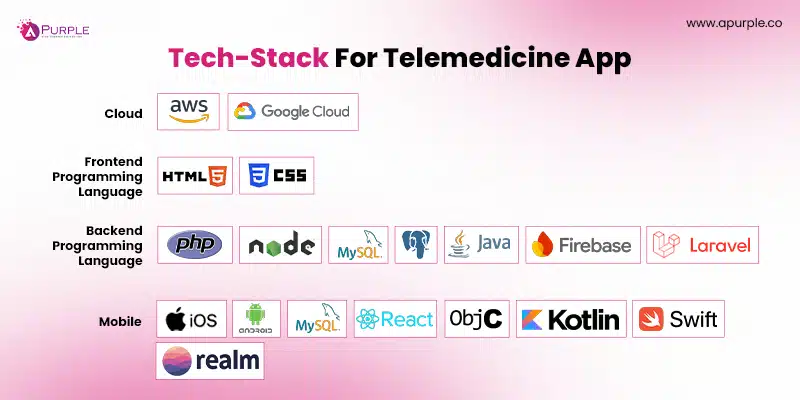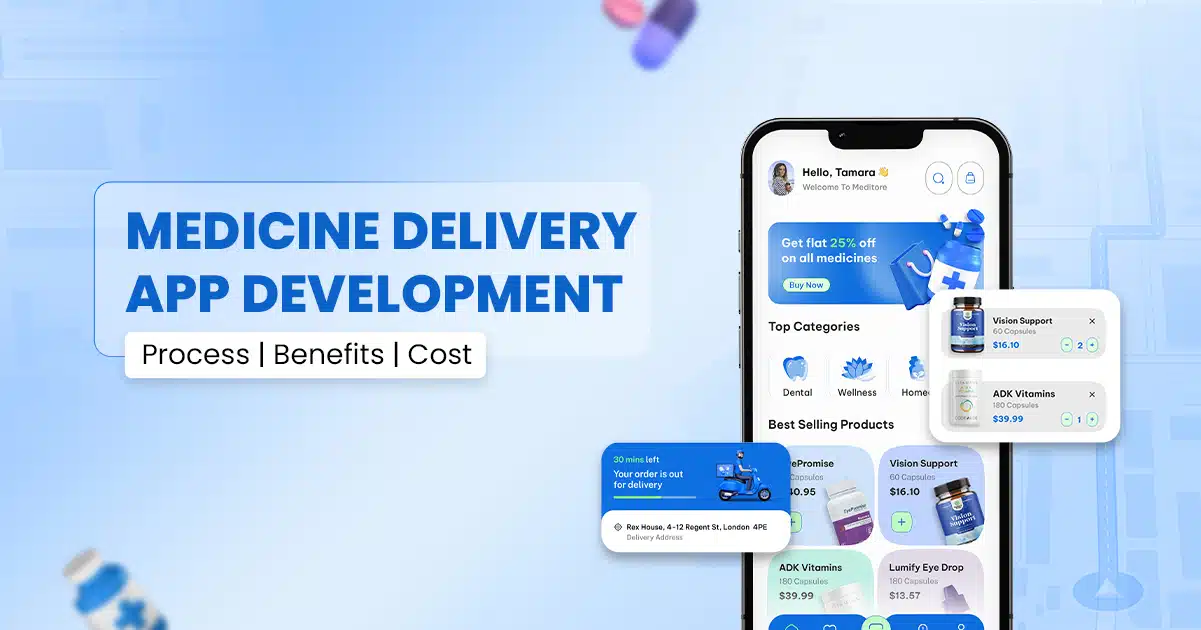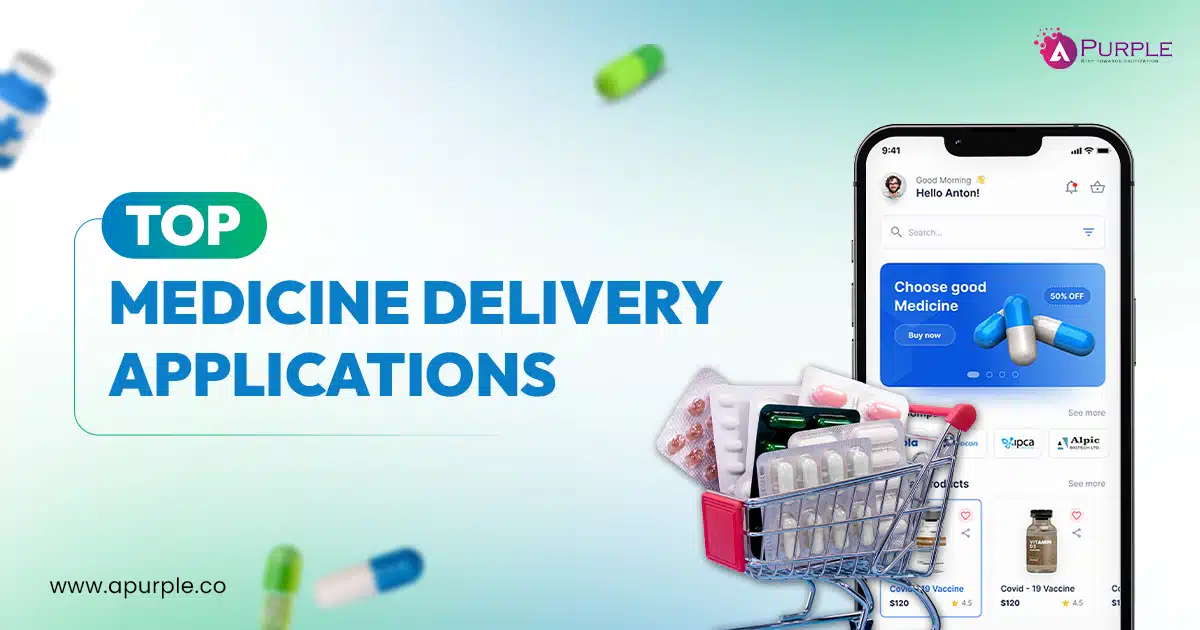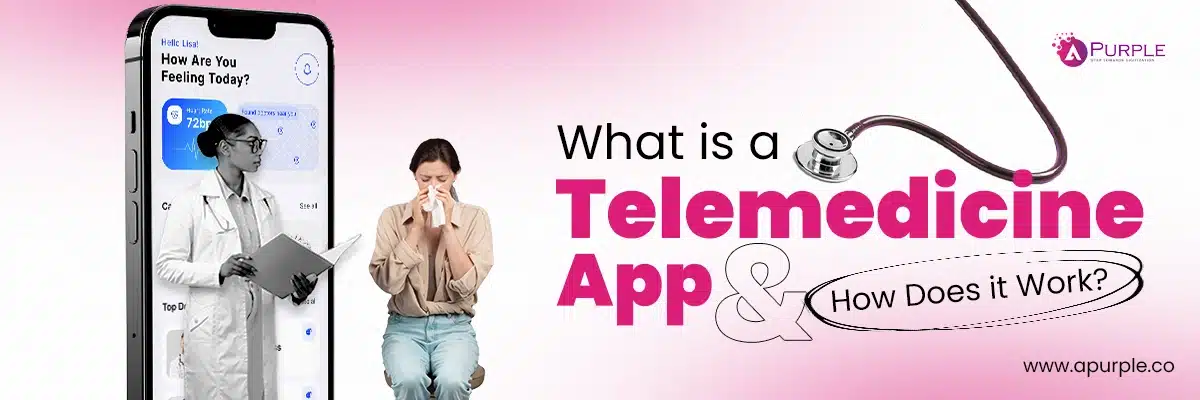
Are you considering developing a telemedicine app? It is the right decision for startups, healthcare centers, and investors. Patients expect more from a medical center, thus increasing the demand for greater convenience and accessibility.
The main aim of a telemedicine app is to bridge the gap between patients and healthcare providers with the help of advanced technologies. This involves remote medical assistance through virtual means like video & audio calls and text messaging. In fact, there is much more than just this; it is the ideal solution for all medical centers.
Where to start with telemedicine app development? This article details the best features to include and essential tips to develop a next-generation solution.
Significance of a Telemedicine App Development
A telehealth platform utilizes advanced technologies to deliver medical services remotely. These platforms typically offer a wide range of features, making it easier for patients to access essential health services when necessary. It’s similar to an on-demand service, allowing individuals to receive timely emergency assistance.
Considering the rise in mobile device usage, it is the perfect solution. Startups can benefit from developing a custom solution. They can either go for a full-fledged telemedicine app development project from scratch or choose a telemedicine clone.
If you want to develop a telemedicine app, watch a quick live demo of our clone solution. It reduces the time and cost needed to develop such applications.
Here are a few reasons why it is essential to develop such an app:
- It makes vital medical care more accessible.
- Increases the level of convenience for doctors and patients.
- Improves the quality of healthcare.
- Reduces the cost of healthcare app.
- Enhances time management for doctors.
- Improves the after-treatment care for patients.
Here are a few relevant statistics, trends, and facts:
- Over 80% of consumers have used a telemedicine app at least once.
- 74% of millennials prefer telehealth medical services over in-person visits to the doctor.
- The global telehealth market size in 2024 is USD 154.55 Billion and is expected to rise to USD 1,211.14 billion by 2034.
- The North American telehealth market size as of USD 12.58 Billion in 2024.
- AI & Machine Learning are greatly influencing telemedicine mobile app development.
Types of Telemedicine Applications
Entrepreneurs can develop several types of telemedicine apps, each catering to different aspects of healthcare.
Here are the main types of apps:
- Video Consultation Apps: Patients can connect with healthcare providers in real-time video calls. It is secure and facilitates remote consultations, follow-ups, and treatment care.
- Remote Patient Monitoring (RPM) Apps: These are some of the best apps for doctors that allow doctors to track patients’ health data in real time.
- Mental Health Apps: Offers tools and resources to help users manage their mental health, such as therapy sessions, self-help exercises, mood tracking, and stress management.
- Medication Management Apps: Patients can manage their prescriptions; this includes tracking, setting reminders & refills.
- Health Monitoring Apps: Users gain the ability to track various health parameters like steps, calories, heart rate, and sleep patterns to improve overall well-being.
- On-demand Therapy Apps: Provides immediate counseling from licensed therapists via text, voice, or video for mental health support.
- Women’s Health And Wellbeing Apps: Focuses on issues specific to women’s health, including menstrual cycle tracking, pregnancy, menopause, and overall physical and mental well-being.
- Chronic Conditions Treatment Apps: Offers management tools for chronic conditions such as diabetes, hypertension, or asthma, allowing users to track symptoms, medications, and progress.
Read also: mental health business ideas that startups can use to innovate in telemedicine.
These telemedicine applications offer a wide range of features that meet the unique needs of medical practitioners. However, if you are a startup, using a white-label telemedicine app makes more sense. A white-label telemedicine solution is a pre-built, fully functional platform that you can customize according to business requirements.
Now that you know the importance of developing a telemedicine app, it’s crucial to understand how it works. This will help you understand key requirements and plan the project accordingly.
Working Steps of Telemedicine App
A telemedicine application helps patients connect with medical practitioners and doctors through an online platform. The exact functioning of the application depends on what type of platform or features you develop.
For example:
- Patients can look up the disease database and actively match their symptoms to diagnose their condition.
- Patients can book an appointment using the video, voice, or messaging consulting scheduling system.
- Doctors will consult with the patients based on the appointments or using a virtual waiting room.
These functionalities involve using cloud-based technologies and communication protocols to help patients virtually connect with a medical practitioner. You know by now that features impact the telemedicine app development project significantly. So, understanding the key features needed for your telehealth platform becomes vital.
Must-Have Features of a Telemedicine App
The features of your telemedicine application define the patient experience. For example, if you create a custom chatbot using AI for patients, the user experience will be better than a platform without bots. So, if you are planning a telemedicine app development project, here are some must-have features based on the specific stakeholders.
1. Features For Hospitals & Clinics
- Manage patient prescriptions: This app’s interactive interface feature allows for creating, sending, and updating all patients’ prescriptions.
- Accept payment via the app: It allows you to pay for medical services and doctor consultations via the telemedicine app.
- Configure patient alerts and reminders: It automates appointment notifications, medication schedules, and follow-ups.
- Remotely monitor their patients: This allows doctors to track patients’ health in real-time with the help of connected digital devices.
2. Features For Doctors
- Setup profile and specialty: This feature allows healthcare providers to create detailed profiles specifying their expertise and specialties.
- Connect with patients via video, voice, or messaging: It provides access to features that allow them to seamlessly connect with their patients via video calls, voice communication, and messaging, as the patient requests.
- Manage patient prescriptions: This feature allows creating, sending, and updating all patients’ prescriptions using an interactive interface on the app.
- Accept payment via the app: It allows patients to pay using the telemedicine app.
- Configure patient alerts and reminders: This feature helps automate appointment notifications, medication schedules, and follow-ups.
- Remotely monitor their patients: It helps track patient health in real-time with the help of digital devices.
3. Features For Patients
- Schedule a doctor’s appointment for an online consultation: This is an interactive interface to book a virtual appointment with a doctor or a specialist based on your medical condition.
- Register account: This feature helps to create personal profiles to manage their health information and appointments.
- Search using filters: It browses medical practitioners and checks doctor availability, specialties, location, and more. The filter option allows users to fine-tune their search.
- Receive alerts and reminders for medication and appointments: This feature receives notifications regarding upcoming appointments, taking medication, and renewing prescriptions.
- Video, voice, and messaging consultation: It offers to consult your physician via secure, voice, and instant video calls.
- Access disease database: This provides a searchable library of diseases, symptoms, and treatments for patient reference and education.
- Symptom Checker: This gives users quick access to an AI-powered symptom checker to feed their symptoms. The system analyzes medical conditions and provides details about potential conditions and possible treatments.
- Virtual Waiting Room: The virtual room in the telemedicine app offers waiting for your session in a virtual waiting space (queue management system).
- AI and Chatbots for Preliminary Consultation: This implements AI-driven chatbots to collect patient information and provide initial guidance or triage.
- Analytics and Reporting: It generates detailed insights and reports on patient data, doctor performance, and overall system usage.
4. For Lab Technicians
- Profile Management: It allows users to create, update, and manage their personal and professional profiles within the system.
- View Requests: This feature lets users view and track incoming requests, such as appointments or consultations.
- Task Allotment: It depends on the department that assigns medical analysis tasks to team members, ensuring efficient workload distribution and management.
- Report Sharing: Enable secure sharing of reports, such as medical or performance reports, with relevant stakeholders.
Must have Advanced Features of Telemedicine App
- Virtual Reality (VR) and Augmented Reality (AR) for Health Education: Utilize VR and AR technologies to enhance medical training and patient education through interactive and immersive experiences.
- Blockchain for Secure Health Data Sharing: Blockchain solutions improve the security of patient health data. Sharing patient health data between authorized parties also helps make transactions more transparent and decentralized.
- Voice Recognition for Hands-Free Interaction: Enable voice-driven commands and interactions, allowing healthcare providers and patients to use systems without manual input.
- Geolocation and Emergency Services Integration: Integrate location-based services to provide real-time location tracking for patients, ensuring quick access to emergency medical services.
Businesses can benefit from consulting the experts for a next-generation telemedicine app development solution. aPurple is one such firm that is trusted by top startup companies worldwide.
Design Principles for Telemedicine Apps
Designing telemedicine apps is about building a smooth user experience while ensuring functionality and security. Let’s look into some key design principles to keep in mind:
1. User-Centric Design
- You have to design the app to be simple and easily navigable for every group of users, regardless of their tech skills.
- Include straightforward options for booking appointments, video calls, and document sharing.
2. Security and Privacy
- Use strong encryption and secure login methods that keep the health data safe.
- You must follow privacy laws like HIPAA or GDPR to protect user information.
3. Accessibility and Inclusivity
- The app should support multiple languages and features like voice commands and text-to-speech.
- Ensure that the app works well with tools that help users with disability.
4. Responsive Design
- The design should support and look suitable for all devices, such as mobile phones and tablets.
- You have to ensure that all communication works smoothly across all devices.
5. Integrated EHR Systems
- Allow integration with Electronic Health Records (EHR) so user can view their medical history.
- You must ensure that information updates seamlessly for patients and healthcare providers.
6. Real-Time Communication
- Aim for quality video and audio communication with minimal delays during consultations.
- Include chat options for quick follow-up questions.
7. Appointment Scheduling and Reminders
- Offers easy book appointment options with automatic reminders
- Provide flexible time slots and allow adjustments for different time zones.
8. Scalability
- Building an app allowing features like multi-doctor consultations and advanced AI tools.
9. Clear Call-to-Actions (CTAs)
- Use bold buttons like “Book Appointment” to guide users easily through the app.
- Make quick, actionable navigation so users take steps without getting lost.
10. Integration with Wearables
- Provide connectivity with wearable devices, like fitness trackers, for real-time monitoring.
Telemedicine apps that focus on these principles can provide a smooth, secure, and practical healthcare experience for patients and providers alike.
Development Process for Telemedicine Apps
To develop a telemedicine app, you must follow some crucial steps to launch a bug-free app. Here’s a comprehensive 7-step guide to help you through the mobile app development process:
1. Conduct Market Research and Define Your Niche
Thorough market research is the foundation of a successful telemedicine app. It starts by analyzing the telemedicine industry. Identify your target audience based on demographics, healthcare needs, and geographic location.
Pinpoint gaps in the market and define your unique value proposition. For example, are you focusing on mental health or providing specialized care for chronic conditions? A well-defined niche can set your app apart.
2. Establish Compliance with Healthcare Regulations
Healthcare app development must ensure data security and privacy. Compliance with regulations is non-negotiable, as non-compliance can lead to legal penalties and a loss of trust.
- HIPAA (U.S.) requires the secure storage and transmission of Protected Health Information (PHI).
- Features like encrypted communication and secure user authentication are essential.
- GDPR (Europe) focuses on user consent and data minimization for EU residents.
- PIPEDA (Canada) requires secure handling of personal data with explicit consent.
Consult legal experts to ensure your app adheres to all relevant regulations. Incorporate secure data encryption, two-factor authentication, and access controls to safeguard patient information. Regular audits and updates to your compliance practices will help you stay ahead of evolving regulations.
3. Telemedicine App Features
You can choose the features that align with your business requirements and keep upgrading your app with the advanced features in the later phase.
Feature selection will help you to decide on the tech stack for better development.
Here is a list of the best technologies for developing a telemedicine app curated by our experts,
- Backend: Node.js, Python (Django), or Ruby on Rails for server-side logic.
- Frontend: React Native or Flutter for cross-platform compatibility. These frameworks reduce development time and cost by allowing a single codebase for both iOS and Android.
- Database: MongoDB or PostgreSQL for secure and scalable data storage.
- Video APIs: Twilio or WebRTC for secure real-time communication.
- Cloud Services: AWS, Google Cloud, or Microsoft Azure for scalability and reliability.
In the initial phase, you should choose the required features. This will help you lower the development cost and monitor users’ feedback.
4. UI/UX Design of App
The healthcare app design services you hire must have experience developing UI/UX designs that enhance user retention. Here are a few steps to follow for your UI/IX design of a telemedicine app.
- Simplicity: Use clean layouts with intuitive navigation. Avoid overcrowding screens with too much information.
- Accessibility: Incorporate inclusive design elements such as adjustable font sizes, voice commands, and high-contrast modes.
- Responsiveness: Ensure the app adapts seamlessly to different devices and screen sizes.
- Personalization: Provide tailored experiences based on user preferences and behavior.
Wireframe the app’s structure and test prototypes with real users to identify pain points. Use tools like Figma or Adobe XD to create engaging designs. Collaboration between designers and developers is key to ensuring design feasibility.
5. Telemedicine App Development Phase
This phase of the mobile app development process is divided into three parts: frontend, backend, and API integration.
- Backend Development: Building the server-side architecture to handle user requests, data storage, and security.
- Frontend Development: Implementing the user interface based on the finalized design.
- API Integration: Adding functionalities like video calls, payments, and notifications.
6. Test & Deploy
Once your telemedicine app is developed, it must undergo rigorous testing. The most appropriate testing typically includes usability, functional, non-functional, performance, and more.
After testing the app, deploy the app on platforms like the App Store and Google Play. Follow these steps:
- App Store Optimization (ASO): To improve app visibility, use keywords, engaging descriptions, and high-quality visuals.
- Marketing Campaigns: Leverage social media, email campaigns, healthcare blogs, and partnerships to promote your app. Highlight unique features and patient success stories.
- User Feedback: Actively collect feedback through in-app surveys or reviews to identify areas for improvement.
Tech Stack Selection For Telemedicine App Development
The selection of the technology stack is vital to the success of your application. The tech stack needed to develop a telemedicine application that covers everything from the front end to the back end and the database. For a non-tech person, understanding the complexities of the tech stack can be challenging.
This is where we can help you choose the right tech stack for your telemedicine app development project.
How Much Does Telemedicine App Development Cost?
The cost of telemedicine app development can vary depending on several factors. The cost is directly affected by the number of features one adds and its complexity:
- Simple App: USD 20,000 – USD 55,000+
- Medium App: USD 55,000 – USD 85,000+
- Complex App: USD 90,000 – USD 210,000+
The choice of development platform will also impact costs. The standard options include cross-platform, Android, or iOS apps. In-house development incurs more overhead while outsourcing telemedicine app development can be more cost-effective.
At the same time, telemedicine app development company from different countries like India to build the app tends to work out as a more cost-effective option:
| Location | Cost |
|---|---|
| USA | USD 150,000 – 250,000+ |
| India | USD 20,000 – 120,000 |
| Ukraine | USD 70,000 – 2,00,000+ |
| Mexico | USD 40,000 – 2,00,000+ |
Mobile app development companies have a per-hour rate and charge as per the development time. Other factors that affect the overall cost include the selection of the tech stack, maintenance costs, and team size. Knowing the cost of developing a telemedicine application offers insight into what investments may be necessary. However, understanding how to execute telemedicine app development projects is vital to ensuring maximum gains.
How Is Telemedicine App Development Beneficial?
Developing a Telemedicine app benefits doctors, patients, and healthcare providers. It is also a good investment opportunity for startups and small businesses. The global telehealth medicine market is expected to grow at a CAGR of 19.7% between 2022 and 2030. Some key benefits of the development of a telehealth mobile app:
1. Improved Accessibility to Healthcare Services
Patients benefit from being able to consult their doctor regardless of where they are located or what time of day it is. This gives them access to specialists and prescriptions, and doctors can easily monitor their progress.
2. Cost Savings
This option is more cost-effective for all involved, including patients, doctors, healthcare providers, startups, and investors. The main reason is that it lowers the overall cost of healthcare. Patients save by avoiding the expense of going to the doctor. It allows doctors and clinics to manage their patients better and provide high-quality care. It also reduces the investment and maintenance costs involved in infrastructure.
3. Enhanced Patient Engagement and Satisfaction
You must ensure seamless communication and top-notch security, allowing for highly personalized and patient-centered care. The user-friendly design, convenience, and high-quality medical services enhance patient experiences and satisfaction.
4. Reduced Healthcare Burden on Facilities
The app helps streamline resource allocation, minimize resource waste, and ensure maximum utilization of the medical facility. It also improves the quality of service by preventing overcrowding and better-managing patients.
5. Efficient Data Management and Record-Keeping
The doctor in charge can access the patient’s digital records and medical history, including diagnoses and treatment plans. This secure data sharing helps better analyze the condition and provide more accurate medical reports.
6. Improved Healthcare Monitoring & Coverage
The ability to monitor patients using mobile devices like wearables and mobile phones improves overall healthcare monitoring. It helps enhance remote patient monitoring, allowing doctors to access real-time data. Other advantages include better chronic disease management and better care for the elderly.
7. Highly Popular
The growing popularity of this type of app among patients, doctors, and clinics makes it the ideal investment opportunity for small businesses, startups, and healthcare investors.
Tips For Telemedicine App Development
Telemedicine app development requires careful planning, a user-centered approach, and attention to both technical and regulatory requirements:
- Study the healthcare regulations in the local region first (HIPAA, GDPR).
- Prepare a clear picture of the type of healthcare solution before contacting the experts.
- Consider developing MVP solutions to start with.
- Focus on the healthcare app design phase to ensure it has an interactive and intuitive user interface.
- Include real-time video, voice, and messaging communication.
- Prioritize security and privacy during telemedicine app development.
- Implement AI tools and introduce automation.
- Include multiple language support to eliminate the language barrier.
- Integrate electronic health records (EHR) for optimal health care services.
- Ensure high scalability during telemedicine app development to handle increased users or traffic.
Common Challenges That Entrepreneurs Face While Developing Telemedicine Apps
Competing in the healthcare market is quite a challenge. It is an enormous battlefield where many companies try to gain a good market share.
Here are some of the common telemedicine app development challenges:
1. Data Security and Privacy Concerns
An application of this nature must securely store essential patient information, including personal details, medical records, and current health conditions. Therefore, it is crucial to ensure a high level of security. In the United States, such applications must comply with HIPAA regulations.
2. Integration with the Healthcare System
To be practical, an application of this nature must comply with electronic health records (EHR), Laboratory Information Systems (LIS), and other medical databases. The necessity for integration depends on the system’s overall design. Nevertheless, patients and physicians anticipate certain features from a system of this kind.
3. Regulatory Compliance
To guarantee compliance with regulations, clinics and hospitals must consider the rules set by local counties, states, or cities. This can become complex for those offering services across multiple regions or countries.
4. Scalability
Telemedicine applications must be scalable to meet the demands of your medical practice. For example, if your clinic currently handles 1,000 video consultations, the telemedicine app should be able to handle more than 100,000 consultations if necessary.
5. Healthcare Provider Verification
Ensure that the registered doctors of a healthcare portal or clinic have the necessary medical certifications and licenses. This can be a challenge, especially for large-scale hospitals with many doctors, medical practitioners, nursing staff, etc. By leveraging telehealth app development, these hospitals can create custom modules that enable the management of healthcare services.
Popular Telemedicine Apps
1. MDLIVE
The Mdlive application allows patients to talk to doctors all around the clock. It also allows doctors to collaborate with health professionals and receive training.
2. Teladoc Health
Apps like Teladoc Health give patients access to doctors with various specialties and features like video, phone, and chat.
3. Doctors on Demand
As the name suggests, Doctors on Demand provides 24/7 instant access to licensed medical experts, such as general practitioners, psychologists, counselors, and chiropractors.
4. Babylon Health
The Babylon Health app provides 24/7 health care services. Its interactive interface allows patients to schedule doctor appointments and receive prescription deliveries.
5. Dialogue
The dialogue provides secure healthcare services, including live video sessions. Patients can search for doctors and nurses, and AI-powered chatbots offer quick help.
6. Talkspace
Talkspace is a telemedicine app that allows users to search for a therapist. It features in-app chatting, progress tracking, and live session scheduling.
Popular Approach For Telemedicine Business Monetization
Startups, small businesses, and investors in healthcare solutions can benefit from telemedicine app development since many monetization strategies are available. Arranging a fixed percentage commission on the doctor’s fees is a common strategy many follow. However, there are many other strategies that one can implement:
1. Pay Per Appointment
As the name suggests, the platform charges a fee for each patient’s doctor appointment. Popular examples of this are the Teladoc business model and Amwell.
2. Subscription Model
This model generates revenue through a subscription fee to access the doctor. It can be designed to allow patients unlimited doctor consultations. This model enables the practice of medicine for a fixed duration.
3. SaaS Model
A typical Software-As-A-Service model is also a good monetization strategy. This involves developing a telemedicine SaaS platform and providing healthcare centers and clinics with an app to use it. The usage of the services via the app can include a recurring cost.
4. Transaction
All transactions performed on the telemedicine app will include a charge by the platform. This popular method is followed when the platform has multiple healthcare providers and services. Some popular telemedicine apps that follow this model include MDLove and LiveHealth Online.
5. In-app Ads
This telemedicine app offers a wide range of medical services and includes Ads in its mobile application. Revenue generation in this app type depends on the firms that display the ads. Two very popular platforms, MyTheraphy and Dr. On-Demand, use this app.
6. Freemium Model
This is a popular revenue generation model for mobile apps in general. It generally involves providing free access to the app for all types of users. However, it will also include many premium services which are only accessible at a cost.
7. Insurance-Based Model
Several telemedicine apps partner with insurance companies that pay the platform a fee per member or every month. This arrangement works because a patient consults a doctor, who the health insurance provider then pays.
8. Health Data Research
Telemedicine apps routinely gather gigabytes of patient data, which is valuable for pharmaceutical firms and research organizations. Hence, selling this data to such organizations is a popular revenue source. This is usually done with the consent of the patients using the platform. Popular examples of this model include Omada Health.
Future Of Telemedicine App Development
The future of telemedicine apps is bright and rapidly evolving, driven by technological advancements, changing patient expectations, healthcare access improvements, and regulatory adjustments. The future of technologies in telemedicine is poised for rapid growth and innovation with trends like:
- AI technologies offer immersive experiences for healthcare providers and patients, improving diagnosis, treatment simulations, and therapeutic interventions.
- Blockchain will offer decentralized, secure solutions for managing patient health records, ensuring privacy, and enhancing trust in telemedicine systems by safeguarding sensitive data.
- Voice-activated systems will make telemedicine platforms more user-friendly, allowing healthcare providers to interact hands-free. Natural Language Processing (NLP) will assist in transcription, data entry, and clinical decision support.
Telemedicine Apps Built By aPurple
Executing telemedicine applications involves development, testing, deployment, and continuous high-performance assurance. Here are some examples of robust telemedicine app projects delivered by aPurple, a provider of high-performance solutions.
1. Telemedicine App That Makes Virtual Consultations Seamless
Our team helped a client develop a telemedicine platform to simplify patient access to healthcare assistance (remotely). The client was an independent medical practitioner who needed a reliable, scalable, and robust platform for video consultations. A team of dedicated telemedicine app developers helped the client create advanced features like AI-based symptom tracking.
Key Features:
- Video consultations
- AI-driven symptom checkers
- Integration with wearable devices
- Prescription management
Challenges:
- Ensuring HIPAA compliance and robust data security
- Integrating multiple services on a single platform
- Managing real-time video streaming quality
The telemedicine app we built offered real-time video consultations at scale. With the platform, medical practitioners could provide healthcare services to more than 20 patients per day.
2. Telemedicine App Enhances Remote Patient Monitoring
Our team partnered with a healthcare provider to develop a telemedicine platform to improve remote patient monitoring and chronic disease management. The multi-specialty medical group client required a secure, scalable, and user-friendly solution to facilitate continuous patient care beyond traditional clinical settings. Our dedicated developers integrated advanced features like real-time health data analytics and personalized treatment plans.
Key Features:
- Continuous tracking of vital signs like blood pressure, glucose, and heart rate.
- AI-driven analysis to detect anomalies and predict potential health issues.
- Customized care plans based on individual health data and medical history.
- Encrypted communication between patients and healthcare providers.
Challenges:
- Integrating various medical devices and wearables to collect precise health metrics.
- Adhering to healthcare regulations such as HIPAA to protect patient information.
- Encouraging consistent patient participation and adherence to monitoring protocols.
The telemedicine app we developed enabled healthcare providers to monitor patients’ health in real-time, allowing for timely interventions and personalized care.
Within six months of implementation, the platform contributed to a 25% reduction in hospital readmissions and a 30% improvement in patient adherence to treatment plans.
Conclusion
The Telemedicine app industry is rapidly gaining popularity, and mobile app use is increasing exponentially. There is a high demand for apps that simplify healthcare services, and doctors and patients largely accept them. This article provides a comprehensive guide to telemedicine app development.
It also explains the numerous benefits of telemedicine app development company, like their cost-effectiveness and convenience. There is no time like now to build your telemedicine solution. However, it does require technical expertise and knowledge of how a healthcare platform operates. This is where aPurple can come to the rescue.
Here’s what makes aPurple your ideal partner for telemedicine app development.
| Unique Selling Proposition | aPurple | In-House | Freelancer |
|---|---|---|---|
| Weekend Support | Yes | No | No |
| Dedicated Resources | Yes | Yes | No |
| Termination Cost | No | High | No |
| Project Manager Cost | No | High | No |
| Query Support | 24×7 | High | No |
| Time to Start a Project | 1 Day – 2 Weeks | 2 – 10 Weeks | 1 – 10 Weeks |
| Hiring Model | Monthly, Part & Full Time | Full Time | Weekly, Hourly |
| Recurring Cost of Training & Benefits | 0 | 10K – 30k USD | 0 |
| Time to Scale Size of the Team | 48 Hours | 4 – 16 Weeks | 1 – 10 Weeks |
| Availability 24×7 | Seamless | Seamless | Uncertain |
| Agile Development | Yes | Maybe | No |
| Free Trial | 7 Days | No | No |
Get in touch with us for competitive telemedicine app development. The table below explains in more detail the benefits of outsourcing to aPurple.
FAQ

